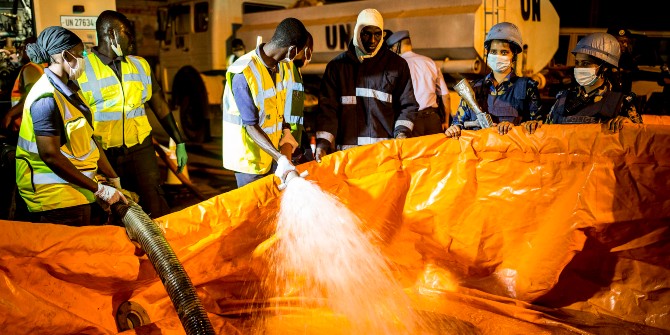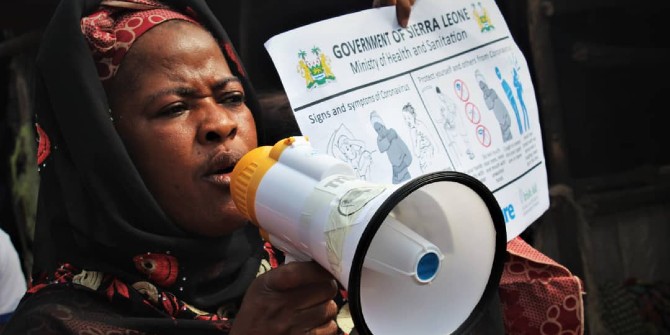Development financing in Sub-Saharan Africa has already fallen, and funds are now being reallocated to COVID-19 projects. Jessica Omukuti and Matt Barlow (University of York) say NGOs need to draw on local expertise before making cuts and changing programmes.
Funding is critical to an effective Covid-19 response in Sub-Saharan Africa (SSA). LSE COVID-19 recently ran a post pointing out that high debt is likely to limit SSA countries’ ability to respond to Covid-19. This means that debt relief for SSA countries will do little to address the funding deficit. Countries and their development partners will now have to make difficult budgetary decisions.

The current international financing in SSA favours the use of debt-based instruments designed for governments. Limited funding is available for other non-governmental development actors, which are dependent on grant-based financing. What does this mean for social equity in the region?
COVID-19 has already led to cutbacks in financing
A significant proportion of development funding in SSA comes from international development finance—specifically through private sector investments and official development assistance. In 2017, the OECD highlighted the sheer scale of this funding, reporting that external flows to Africa in 2017 would rise to $179.7 billion—$85.9 billion higher than domestically generated revenues. With external inflows accounting for such high levels of financial activity in the region, any reduction in these would increase already strained financial pressures and hinder efforts to deal with the pandemic.
However, external development financing targeted towards developing countries has already fallen. In May 2020, the OECD projected that financing to developing countries from external private actors is likely to fall by $700 billion in 2020 from the levels reported in 2019, which is 60% higher than the contraction in flows witnessed during the 2007/8 financial crisis. The UK’s Foreign & Commonwealth Office, for instance, announced a £2.9 billion reduction in ODA spending from its planned 2020 expenditure. This funding shortfall is projected to extend beyond 2021. To make matters worse, falling economic activity will hamper SSA countries’ ability to raise funds through domestic taxes.
International development financing was already diminishing even before the pandemic. The income of international NGOs was already falling, increasing their reliance on institutional donors whose budgets are also constrained due to COVID-19.
Some funding solutions have been proposed for SSA governments and their development partners. A report by ODI in early 2020 highlighted that governments and other development actors could leverage concessional and non-concessional lending from development finance institutions (DFIs) and official development assistance through bilateral and multilateral channels.
DFIs have made a range of financial products available. Organisations such as the IMF have created additional channels for accessing finance, most of which are based on debt service relief. The UK’s Department for International Development (DFID) also provided £120 million (global response) while the African Development Bank (AfDB) has provided $10 billion through different channels, including rapid response pathways to fund COVID-19 responses.
Most of these funds are lending-based, and the main recipients are the governments of SSA countries. Grant-based finance in $USD represents a very small proportion of available international COVID-19 funding. For example, the IMF’s $500 million Catastrophe Containment Relief Fund (CCRF) has been made available to 25 low-income countries globally for debt relief, 18 of which are in SSA. An analysis by Devex indicated that as of May 2020, grants were less than 10% of the total international COVID-19 response funding in West and Central African countries.
Both grant- and loan-based funding for COVID-19 has been spent on primary healthcare and social protection. The government of Zimbabwe requested AfDB funds to use to purchase PPE, sanitation kits and training of community healthcare workers in Harare. Other funds approved by the AfDB for the Sahel Zone’s Group of 5 countries (Mauritania, Mali, Burkina Faso, Niger and Chad) were spent on primary healthcare provision and social protection for vulnerable groups such as refugees.
Shrinking NGO budgets are being squeezed further
The Centre for Global Development notes that funding instruments that prioritise debt do little to support the least developed countries, especially those in SSA, to achieve long-term COVID-19 recovery—especially highly indebted countries that require grants, as opposed to further loans. Additionally, the allocation of these new funds is limited to specific types of organisations. For example, funds provided through DFID’s Rapid Response Facility were only awarded to international NGOs which excluded other regional and national NGOs, and are still considered to be insufficient to address the needs of developing countries.
The limited grant-based funding for COVID-19 responses means that the SSA development funding deficit will persist, and compromise COVID-19 recovery. Non-governmental development organisations which mainly depend on this funding framework are now exploring existing and new sources of finance. Most institutional donors have asked development organisations to reallocate existing programme funding and to implement budget cuts. The European Union and African Development Bank have been working with their partners to reallocate funds from existing programmes to address the funding needs in SSA.
Some organisations, such as UNHCR and Operation Smile, say funds have been reallocated from programmes that could not be implemented as originally intended and towards support for national COVID-19 healthcare programmes in SSA. The European Investment Bank reported redirecting funds from trade-related investments to sectors most impacted by the pandemic. Other organisations in SSA have indicated that donors providing new grant-based COVID-19 funding are prioritising advocacy. According to the Centre for Global Development (CGD), for organisations working in sectors such as education, budget cuts and fund reallocation could mean less capacity to deliver key services for vulnerable groups such as schoolgirls.
Resource reallocation should be based on local needs and priorities
Data and information about the extent of budget cuts and resource reallocations within organisations remains scarce, and will probably become more apparent as SSA countries move from COVID-19 response to recovery. But we must ask ourselves whether the reallocated budgets and cuts are based on the actual needs of SSA countries. Some development organisations in the region have put contingency plans in place in response to the financing deficit, based on a range of projected funding scenarios. However, early findings from research by IGDC (University of York) shows that institutions were unprepared for the funding crisis. Some lacked clear and standardised guidelines on budget reallocation and priorities. The risk is that these cuts will prioritise DFIs and institutional donors rather than being informed by local expertise and representatives of social groups that are most affected by COVID-19. This is particularly true in social infrastructure sectors, where donor financing makes up the majority of funding (as opposed to domestically-sourced development financing). Complex organisations like the African Union, which must juggle the demands of member states, donors and private sector development partners, will have to address the funding deficit in ways that prioritise marginalised voices.
This post represents the views of the authors and not those of the COVID-19 blog, nor LSE.






1 Comments